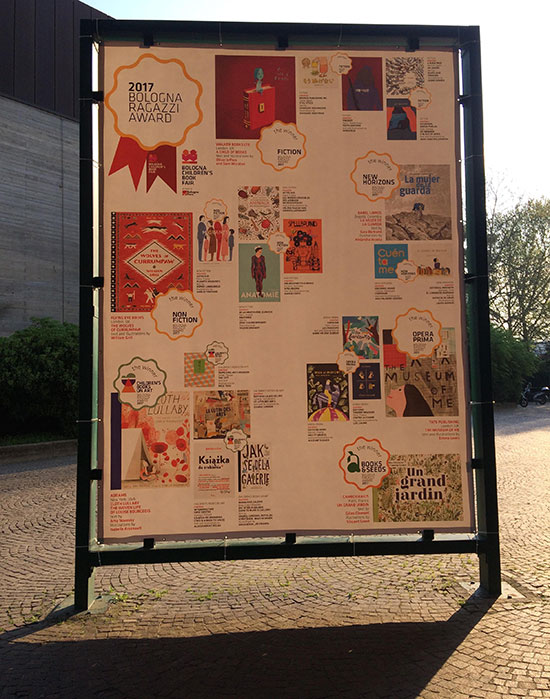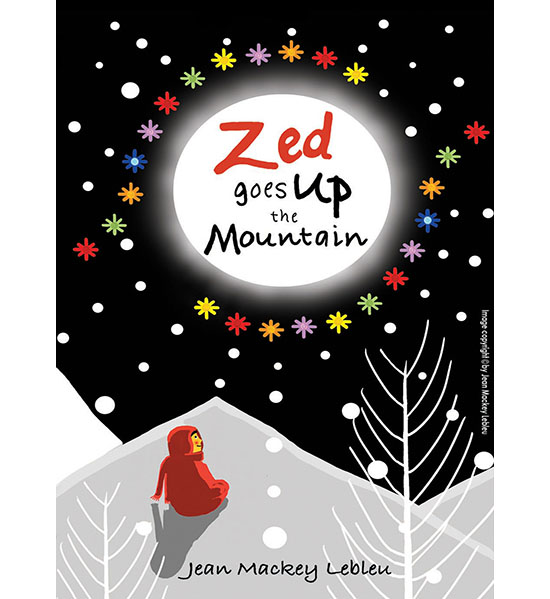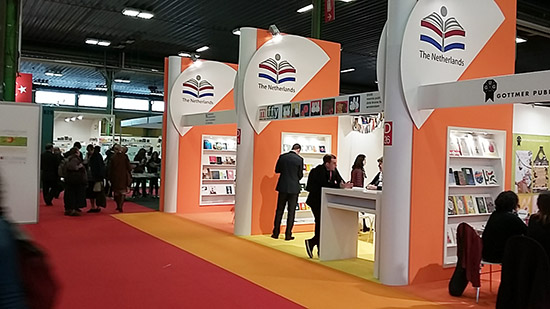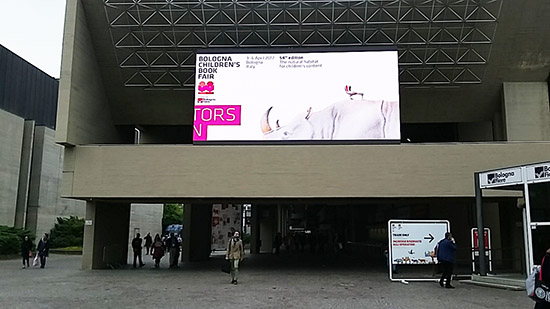Bologna Children’s Book Fair: Before, During and After – Part One
Jean Mackey Lebleu, Illustrator and AOI Member, draws on her experience of visiting the world’s largest children’s book fair to give illustrators guidance on attending in 2018.
The 2017 Bologna Children’s Book Fair ended in early April, so you know what that means… time to start preparing for the 2018 fair (said Jean in May 2017). I’m only half-joking – I learned a lot from my very first visit this year, and preparing in advance definitely helped me to make the most of the trip.
Here are some suggestions for preparing now; as we get closer to BCBF2018 I will submit more suggestions on how to make the most of the fair before, during and after your visit.
Part One: What You Can Prepare Now for BCBF18
Sign up for the BCBF email alerts/newsletter here, at the very bottom of the page and follow them on the social networks; the new Twitter hashtag is #BCBF18.
If you were born before 31 December 1999, be on the look-out for their online announcement to submit work for the Illustrators’ Exhibition of the Bologna Children’s Book Fair. For 2017, if you entered, you were eligible for FREE admission to the fair, for a savings of up to 80€. Click here to see last year’s requirements and links to more information; you’ll note that the contest for 2017 closed in October. You can also try writing to [email protected] to see if they can tell you when the 2018 contest will be open for submissions, and if they can confirm whether or not the free entry tickets are for all entrants or only those who win.

Photograph by Jean Mackey Lebleu
Start now to update your portfolio, prepare dummy books, create ‘leave behind’ samples and update/increase your online presence. Begin by making a list of the publishers you would like to meet at the fair. Many of them host Open Portfolio Reviews (more on that in a future blog) and you want to be fully prepared for them. If you need ideas for publishers, look at the list of exhibitors who were at the 2017 fair.
Ask yourself, which publishers have a catalogue or approach with which your style would be compatible? Then write your Wish List of publishers, follow their websites and also their social media profiles. Closer to the fair opening, they may make announcements about portfolio review appointments or a special event. It’s important to be organised and clear in your mind about your Wish List because otherwise it can become overwhelming, and then you run the risk of missing out on meeting a publisher you really wanted to meet.
Review your portfolio against your target publishers’ existing catalogues and their news. How can you make a contribution to their business that does not duplicate what they already have? What are your strengths – storytelling? Character rendering? Pre-school? Middle-grade? Teens? Make a portfolio that focuses on your strengths and areas of interest, rather than trying to be ‘all things to all people’.

Dummy book of Zed Goes Up The Mountain by Jean Mackey Lebleu ©
Do you want to write as well as illustrate your own books? If so, then you absolutely must bring at least one dummy book or books you’ve had published. They will need to see your storytelling abilities in action. Start that dummy book now!
An A4 size portfolio is perfectly acceptable and in some cases even showing work on a tablet was fine. For leave-behind samples and business cards, paper quality should of course be sturdy and present your work in the best way possible, but it’s not necessary to spend a fortune or to buy more than around 100 copies.
Practice talking about yourself and your work in concise and compelling terms. What is your ‘unique selling proposition’ – what makes your approach different from the others? What is your area of focus? Think about the areas mentioned above – pre-school vs. teens, comics vs. picture books, etc. Also, be able to describe each of your books in one sentence that includes the genre, target audience, who the main character is, the plot and the moral. Write out this ‘elevator speech’ if necessary, for practicing. This will be very useful during portfolio reviews; if you get to speak it will have to be very quick as you usually get only three to five minutes.

Bologna stone. Photograph by Jean Mackey Lebleu
When planning your stay, bear in mind that although the fair is four days, the first three days will be the most helpful for you. On my fourth day this year, many exhibitors had left, there were no more portfolio reviews, the last talk ended near noon and the fair ended at 3pm. Start researching hotels at your leisure now, because you don’t want to be in a rush and end up miles away, or with a bad hotel deal, because you were unfamiliar with the city or ran out of time. When you research hotels, of course look at a Bologna map so you can be clear about how near or far you would be from the fair and how many buses you would need to get there. You can get a lot of information from bolognawelcome.com but some of the links are not in English. There are a few maps at the bottom of this linked page that could be useful.
And finally, make sure your passport won’t expire before March 2018!

Photograph by Jean Mackey Lebleu
There are more, very specific, suggestions to come in early autumn, but laying out your unique selling propositions, choosing your target publishers, updating your portfolio and online presence and making dummy books are things to start right now because they take time. The more time you have to print, the more money you can save by avoiding the need for express services. Starting early also leaves you time to fix unexpected errors. So get going, and we’ll be back with more suggestions in a few months.
See part TWO here.

Back to News Page

